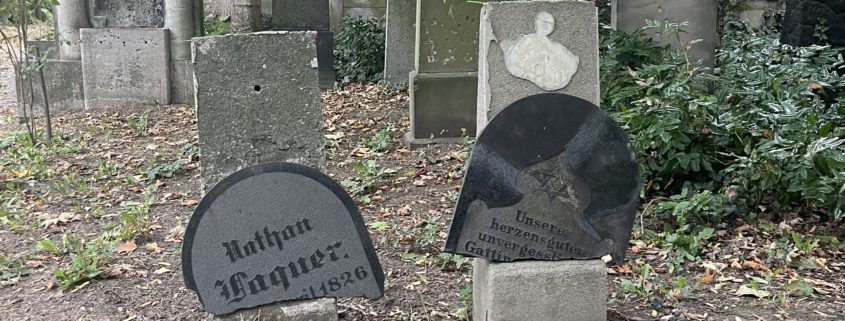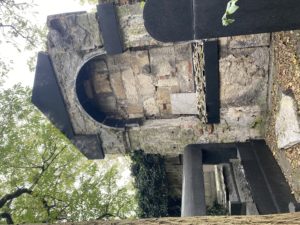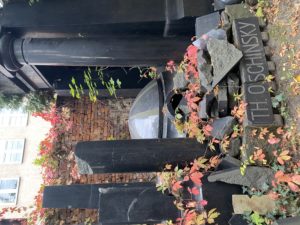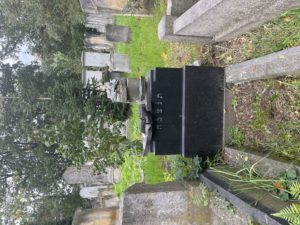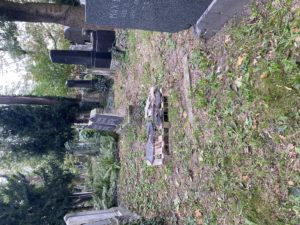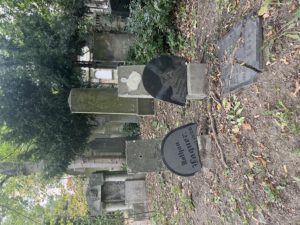An Ode to The German Jewish History of Wroclaw
By Maddie Hartog
“After every war
someone has to tidy up.
Things won’t pick
themselves up, after all.”
(The End and the Beginning, Wislawa Szymborska)
If you ask me about my study abroad, I will say I am studying in Wroclaw, Poland, where the people speak Polish, pierogies are abundant, and Zabka convenience stores can be found on nearly every corner. I went my first two months living here without deeply considering the German heritage of this city, nor acknowledging the Jewish population that lived here prior to World War II. It was not until entering the large “Stary Cmentarz Żydowski we Wrocławiu” or the “Old Jewish Cemetery” that I was reminded that this was a former German city and once the home to a large Jewish community. In this space, Szymborska’s poem echoed as we walked by restored graves, some with missing metal decorative elements that had been looted. Some stone markers had bullet holes, others were shards sorted in piles waiting to be reassembled. To fully understand the role this cemetery plays in the history of Wroclaw, I will rely on three main aspects of analysis: the cemetery’s history, my own readings and inferences of this space, and the Szymborska poem, “The End and the Beginning,” about who cleans up after war.
At the cemetery’s creation in 1856, Wroclaw was a German city named Breslau and it was established for the city’s growing Jewish population. The cemetery continued to serve the German-Jewish population until 1902, when it was full and unable to accommodate more burials. Walking around this cemetery, thousands of gravestones are densely placed in even rows. The only available places appear in family plots or mausoleums, where empty spaces on markers signal planned burials for future generations. There are large graves, some elaborately decorated, indicating wealthier families, and smaller, simpler grave markers that are placed closer together, commemorating community members of more humble means. (Golden, 2023). One row of graves on the edge of a walkway are marked with dates from the 1940s during the Nazi era. Positioned in a single line; these are the final burials here of people discreetly joining their lineage long after the cemetery was closed.
After 1902, a new German-Jewish cemetery was built in Wroclaw. This newer cemetery is less central, but much larger and became the main burial place for Breslau’s Jews from 1902 to 1939. That cemetery too was little used during the war at a time when Jews were forced to leave to escape persecution or were sent to concentration and extermination camps and killed. Right after the war, not only were there limited numbers of Jews in Breslau, but the ones that remained frequently migrated to avoid postwar persecution in Poland and find new communities elsewhere around the world. Additionally, after World War II, when German Breslau became Polish Wroclaw, the city went through, in the words of academic Gregor Thum, “degermanization” or a “repolinization.” Thum describes this time as an attempt where an “extensive national pedagogical programme was developed” to make this former German city more Polish by engraining Polish ideology in the mentality of the residents. Wroclaw became more Polish as academics, journalists and writers made it their mission to propagate “a view of history [that] justified the arbitrary move of Poland 150 miles to the west” (Thum 2003). Surprisingly, the cemetery survived this period of degermanization and is one of the few relics of communal German history in Wroclaw.
Many German-era cemeteries were razed and turned into parks during the Communist period in post-WWII Wroclaw, yet the Jewish cemetery survived. Although there are many possible explanations as to why this occurred, one of the perhaps most common theories is that Wroclaw did have a Jewish population after World War II. Thus, there were people who had connections to this cemetery and would have protested its destruction. Secondly, buried in the cemetery is Ferdinand Lassalle, who was pivotal to the international Socialist movement. It is possible that when the Communist Party took hold in Poland, they were reluctant to abolish this connection to the origins of socialism in Europe—so, the cemetery survived. Although the cemetery was saved, I was shocked by the poor condition of some graves; the holes that I initially assumed were decay were actually bullet holes, legacies of the violence of the Second World War, a reminder of the long shadow of war, embodied in Szymborska’s line saying, “All the cameras have left/ for another war” (Szymborska 2016). The attention was off of this cemetery during the Communist era, and thus, it was further destroyed and pillaged for valuable contents in the graves and the decorative metals that adorned many of the burial plots.
Although the cemetery outlasted the razing of other German-era burial grounds in Wroclaw it’s preservation and partial reconstruction as one of the last relics of Breslau history occurred due to a civic initiative. In the 1980s, two men went to the cemetery to photograph this space. Unsettled by the poor condition of the cemetery, they made it a civic and social mission to restore it. Thus, from 1982-1989 there was near constant restoration of the cemetery, the results of which can still be seen today (Golden and Cervinkova 2021). The restoration process for this cemetery came largely from individuals who cared about the German and Jewish history of Wroclaw. They viewed history as vital to understanding the modern city and took the initiative to save this unique site. These people were not German, nor Jewish, but instead cared deeply about Wroclaw’s past, and understood this destroyed cemetery to be its vital component. By doing the work of restoring the cemetery, these individuals were choosing to keep memory of pre-WWII Breslau alive and allow history to shine, a goal that was nearly impossible after the complete population change and with all the German street names changed and the monuments removed. They did this by voluntarily organizing the restoration of this cemetery.
Today the cemetery plays an important role in the urban memory of Wroclaw. People who pass by this cemetery on their daily commute and others who visit the cemetery, and all are reminded of the history of Wroclaw and its former inhabitants. Even if a commuter, tourist or resident, is not eager to engage with this space, passing it daily will ideally incite curiosity. For those who are more eager, they have a space to learn and grow. By deliberately restoring this site, history is actively being remembered, and not ignorable for those who see this space. Additionally, bodies are not carelessly trampled over, and Jewish Breslau lives on.
The “Old” Jewish cemetery serves as a testimony to the Jewish presence in the city. Some of the graves are in Hebrew or have Jewish motifs on them. As I recognize Hebrew and Jewish symbols, I was able to make connections between this space and the murder of the Jews during the Holocaust. This nod to former Jewish life made me think of the Szymborska poem. She writes, “someone, broom in hand, / still recalls the way it was” (Szymborska, 2016). This narrative reminds me that although our tour of the cemetery was not led by a German Jewish descendant, history is remembered in two ways, people, and spaces. Thus, since Wroclaw has very few Jewish people, recalling what life was like before the war, we become dependent on spaces and cemeteries to remember this reality. Additionally, keeping spaces intact and memory alive is vital to making sure that the histories of those who died unjustly are continually shared. Without the physical space, and those who share stories, memories fade. Therefore, this cemetery is valuable in telling the Jewish history of Breslau, but to tell Jewish history in Central Europe more broadly, we must rely on the people who experienced these times to share these stories in addition to the physical spaces that remain.
Remembering history is important, especially the history connected to mass genocide and the Holocaust. By remembering and discussing topics of genocide and mass extinction, we are able to better conceptualize the weight of these events and the repercussions. This can hopefully allow for it to never happen again. By restoring the cemetery to a respectful condition, and not razing it into a park, people are forced to reckon with this German Jewish history and why this land no longer has Jewish people living here. In Wroclaw, one does not feel the legacy of World War II when walking around. It requires an extra moment to think and to consider. Therefore, creating a central space that is easy to read allows for many to consider the history of German Breslau, the Jews that lived here, and the larger history of Wroclaw.
The Szymborska poem ends with the lines “someone has to lie there/ in the grass that covers up/ the causes and effects/ with a cornstalk in his teeth, / gawking at clouds” (Szymborska 2016). Unlike the beginning of the poem, this phrase talks about the normalcy of these spaces once they are cleaned up, and about how history is easily forgotten. In these lines, there is an ordinary person, lying in the grass that once was filled with destruction, death, and bloodshed. In this space, this citizen is staring at the cloud, not thinking about the death that occurred there. There is privilege in not being forced to understand history that has happened, or the way in which people have worked to restore spaces to their prior beauty; however, just as the Jewish cemetery forces us to do, and as Szymborska does in her other lines, there is a lot to be gained from thinking about history and the reconstruction that follows. Without considering the war and the restoration, the history of Wroclaw is not fully understood, and neither is the German nor the Jewish experience. Thoughtful restoration gives space for connecting to history and understanding its relevance today.
Works Cited
- Golden, Juliet D. and Hana Cervinkova. “On the Peripheries of Memory: Tracing the History of the Old Jewish Cemetery in Wrocław’s Urban Imaginary.” In Diversity in the East-Central European Borderlands Memories, Cityscapes, People, edited by Eleonora Narvselius, Julie Fedor, Journal of Soviet and Post-Soviet Politics and Society, Vol. 5 (2), 127-146. Stuttgart: ibidem-Verlag, 2021.
- Szymborska, Wisława. “The End and the Beginning.” In Map: Collected and Last Poems, 286- 287. Boston: First Mariner Books, 2016.
- Thum, Gregor. “Cleansed Memory: The New Polish Wroclaw (Breslau) and the Expulsion of the Germans.” In Ethnic Cleansing in Twentieth Century Europe, edited by Steven Béla Várdy, T. Hunt Tooley, Agnes Huszar Vardy, 333 – 357. Boulder, New York: Social Science Monographs, 2003

